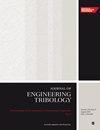The influence of surface topography on mixed plasto-elastohydrodynamic lubrication in point contacts
IF 1.8
3区 工程技术
Q3 ENGINEERING, MECHANICAL
Proceedings of the Institution of Mechanical Engineers, Part J: Journal of Engineering Tribology
Pub Date : 2023-01-26
DOI:10.1177/13506501231152643
引用次数: 2
Abstract
Surface topography plays an important role in mixed lubrication. However, the influence of the surface topography's morphological characteristics on lubrication performance is still not fully understood. In this article, we employ digital filtering and the Johnson transformation system, and we use a mixed plasto-elastohydrodynamic lubrication model to simulate the lubricated contact between rough spherical surfaces with different morphological characteristic parameters. The influence of skewness, kurtosis, and the wavelength factor, that is, the ratio between the autocorrelation lengths in the transversal and longitudinal directions, on contact pressure, film thickness, and von Mises (subsurface) stress, is examined with the mixed plasto-elastohydrodynamic lubrication model. The results confirm that plastic deformation leads to lower pressure distribution, distributed over a larger contact area than the pure elastohydrodynamic lubrication solution. Moreover, it is found that an increase in the kurtosis may improve the lubrication performance, while the opposite is true for the skewness and the wavelength factor. We believe that the insights obtained by means of the numerical simulations presented herein, would facilitate the design and manufacturing processes of the surfaces used for machine elements operating in the mixed plasto-elastohydrodynamic lubrication regime.点接触中表面形貌对弹液混合润滑的影响
表面形貌在混合润滑中起着重要的作用。然而,表面形貌的形态特征对润滑性能的影响尚不完全清楚。本文采用数字滤波和Johnson变换系统,采用混合弹流润滑模型模拟了具有不同形态特征参数的粗糙球面之间的润滑接触。采用混合弹-弹-水动力润滑模型,研究了偏度、峰度和波长因子(即横向和纵向自相关长度之比)对接触压力、膜厚和冯米塞斯(地下)应力的影响。结果证实,与纯弹流润滑液相比,塑性变形导致压力分布更小,分布在更大的接触面积上。此外,发现峰度的增加可以改善润滑性能,而偏度和波长因子则相反。我们相信,通过本文提供的数值模拟获得的见解将有助于在混合塑性-弹性-流体动力润滑系统中运行的机器元件表面的设计和制造过程。
本文章由计算机程序翻译,如有差异,请以英文原文为准。
求助全文
约1分钟内获得全文
求助全文
来源期刊

CiteScore
4.20
自引率
5.00%
发文量
110
审稿时长
6.1 months
期刊介绍:
The Journal of Engineering Tribology publishes high-quality, peer-reviewed papers from academia and industry worldwide on the engineering science associated with tribology and its applications.
"I am proud to say that I have been part of the tribology research community for almost 20 years. That community has always seemed to me to be highly active, progressive, and closely knit. The conferences are well attended and are characterised by a warmth and friendliness that transcends national boundaries. I see Part J as being an important part of that community, giving us an outlet to publish and promote our scholarly activities. I very much look forward to my term of office as editor of your Journal. I hope you will continue to submit papers, help out with reviewing, and most importantly to read and talk about the work you will find there." Professor Rob Dwyer-Joyce, Sheffield University, UK
This journal is a member of the Committee on Publication Ethics (COPE).
 求助内容:
求助内容: 应助结果提醒方式:
应助结果提醒方式:


